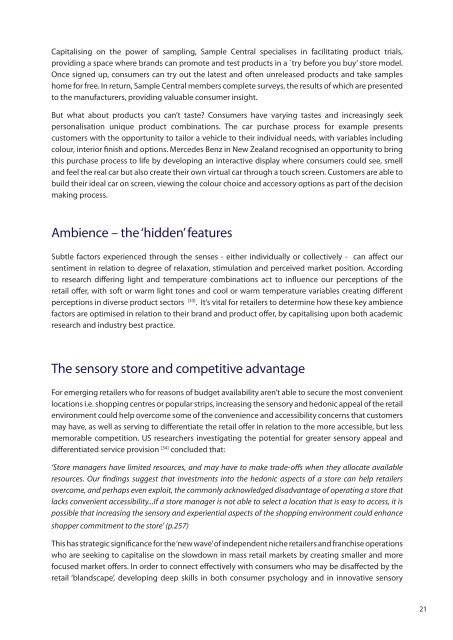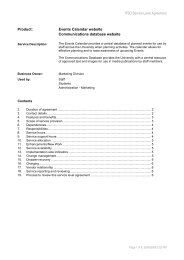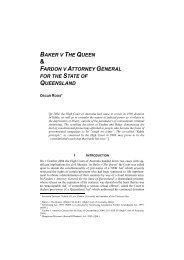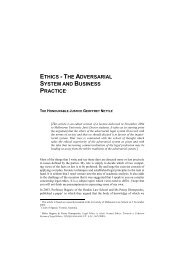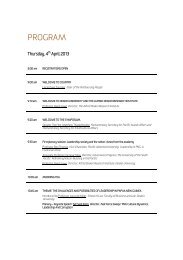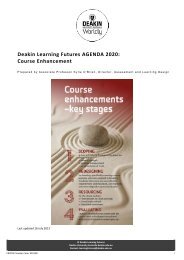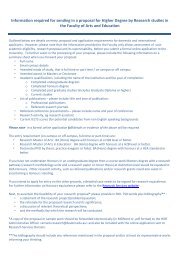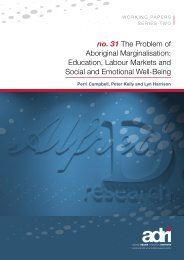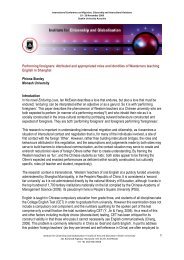Store sense: Reclaiming the four walls with - Deakin University
Store sense: Reclaiming the four walls with - Deakin University
Store sense: Reclaiming the four walls with - Deakin University
You also want an ePaper? Increase the reach of your titles
YUMPU automatically turns print PDFs into web optimized ePapers that Google loves.
Capitalising on <strong>the</strong> power of sampling, Sample Central specialises in facilitating product trials,<br />
providing a space where brands can promote and test products in a `try before you buy’ store model.<br />
Once signed up, consumers can try out <strong>the</strong> latest and often unreleased products and take samples<br />
home for free. In return, Sample Central members complete surveys, <strong>the</strong> results of which are presented<br />
to <strong>the</strong> manufacturers, providing valuable consumer insight.<br />
But what about products you can’t taste? Consumers have varying tastes and increasingly seek<br />
personalisation unique product combinations. The car purchase process for example presents<br />
customers <strong>with</strong> <strong>the</strong> opportunity to tailor a vehicle to <strong>the</strong>ir individual needs, <strong>with</strong> variables including<br />
colour, interior finish and options. Mercedes Benz in New Zealand recognised an opportunity to bring<br />
this purchase process to life by developing an interactive display where consumers could see, smell<br />
and feel <strong>the</strong> real car but also create <strong>the</strong>ir own virtual car through a touch screen. Customers are able to<br />
build <strong>the</strong>ir ideal car on screen, viewing <strong>the</strong> colour choice and accessory options as part of <strong>the</strong> decision<br />
making process.<br />
Ambience – <strong>the</strong> ‘hidden’ features<br />
Subtle factors experienced through <strong>the</strong> <strong>sense</strong>s - ei<strong>the</strong>r individually or collectively - can affect our<br />
sentiment in relation to degree of relaxation, stimulation and perceived market position. According<br />
to research differing light and temperature combinations act to influence our perceptions of <strong>the</strong><br />
retail offer, <strong>with</strong> soft or warm light tones and cool or warm temperature variables creating different<br />
perceptions in diverse product sectors [33] . It’s vital for retailers to determine how <strong>the</strong>se key ambience<br />
factors are optimised in relation to <strong>the</strong>ir brand and product offer, by capitalising upon both academic<br />
research and industry best practice.<br />
The sensory store and competitive advantage<br />
For emerging retailers who for reasons of budget availability aren’t able to secure <strong>the</strong> most convenient<br />
locations i.e. shopping centres or popular strips, increasing <strong>the</strong> sensory and hedonic appeal of <strong>the</strong> retail<br />
environment could help overcome some of <strong>the</strong> convenience and accessibility concerns that customers<br />
may have, as well as serving to differentiate <strong>the</strong> retail offer in relation to <strong>the</strong> more accessible, but less<br />
memorable competition. US researchers investigating <strong>the</strong> potential for greater sensory appeal and<br />
differentiated service provision [34] concluded that:<br />
‘<strong>Store</strong> managers have limited resources, and may have to make trade-offs when <strong>the</strong>y allocate available<br />
resources. Our findings suggest that investments into <strong>the</strong> hedonic aspects of a store can help retailers<br />
overcome, and perhaps even exploit, <strong>the</strong> commonly acknowledged disadvantage of operating a store that<br />
lacks convenient accessibility...If a store manager is not able to select a location that is easy to access, it is<br />
possible that increasing <strong>the</strong> sensory and experiential aspects of <strong>the</strong> shopping environment could enhance<br />
shopper commitment to <strong>the</strong> store’ (p.257)<br />
This has strategic significance for <strong>the</strong> ‘new wave’ of independent niche retailers and franchise operations<br />
who are seeking to capitalise on <strong>the</strong> slowdown in mass retail markets by creating smaller and more<br />
focused market offers. In order to connect effectively <strong>with</strong> consumers who may be disaffected by <strong>the</strong><br />
retail ‘blandscape’, developing deep skills in both consumer psychology and in innovative sensory<br />
21


